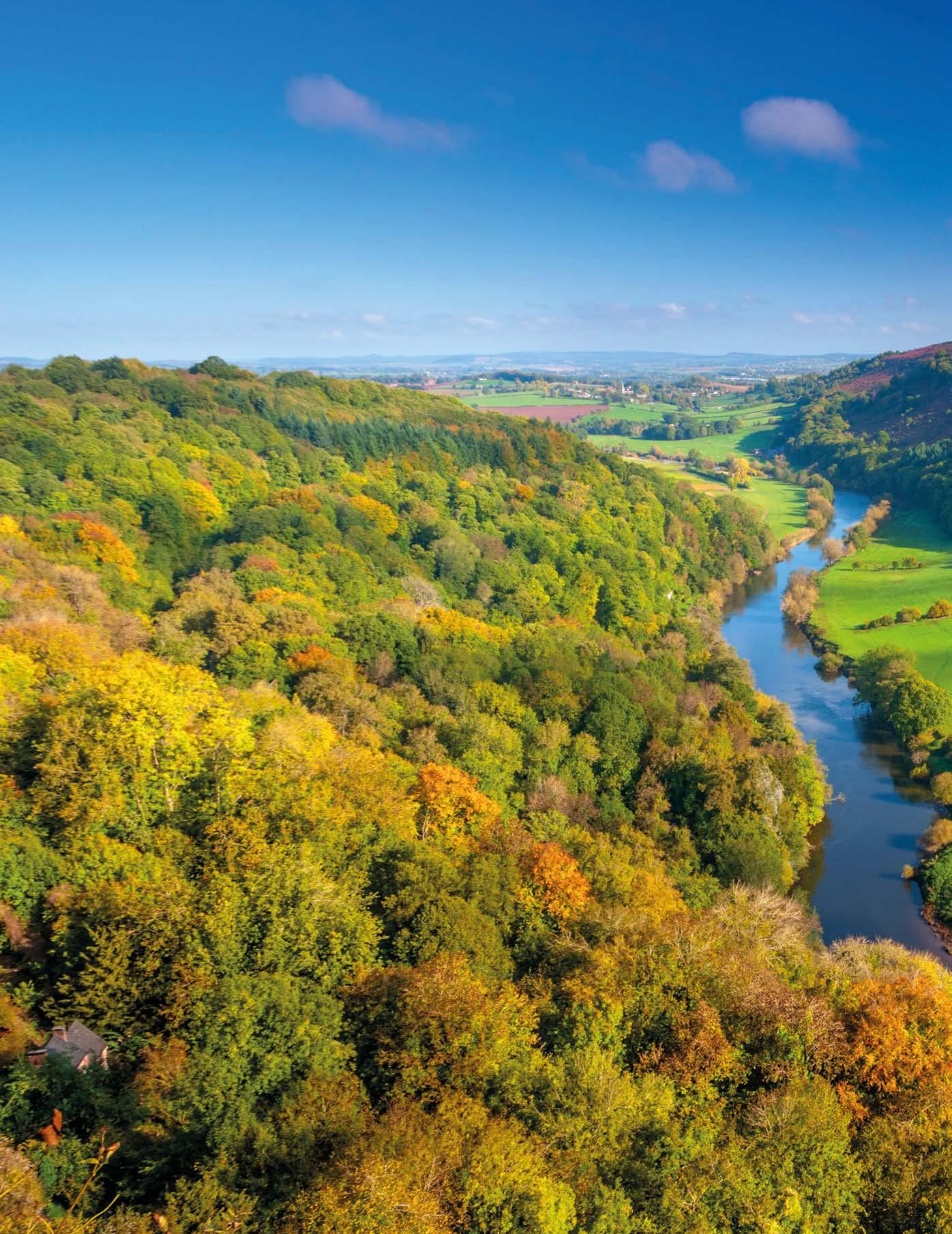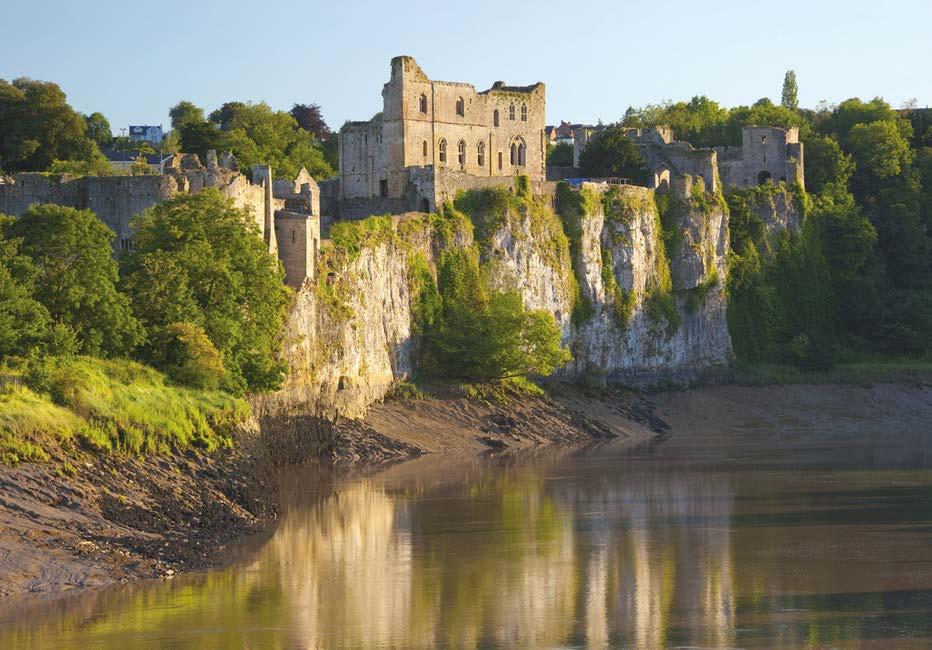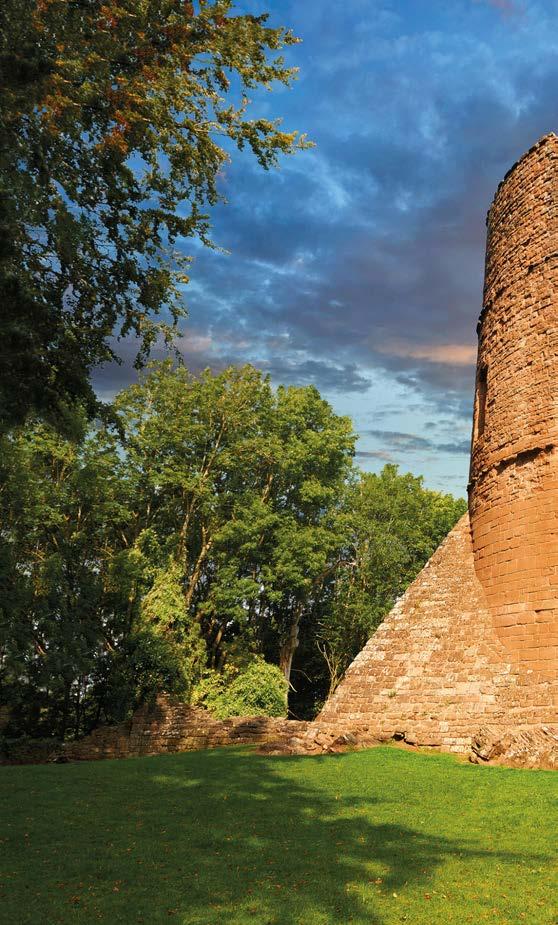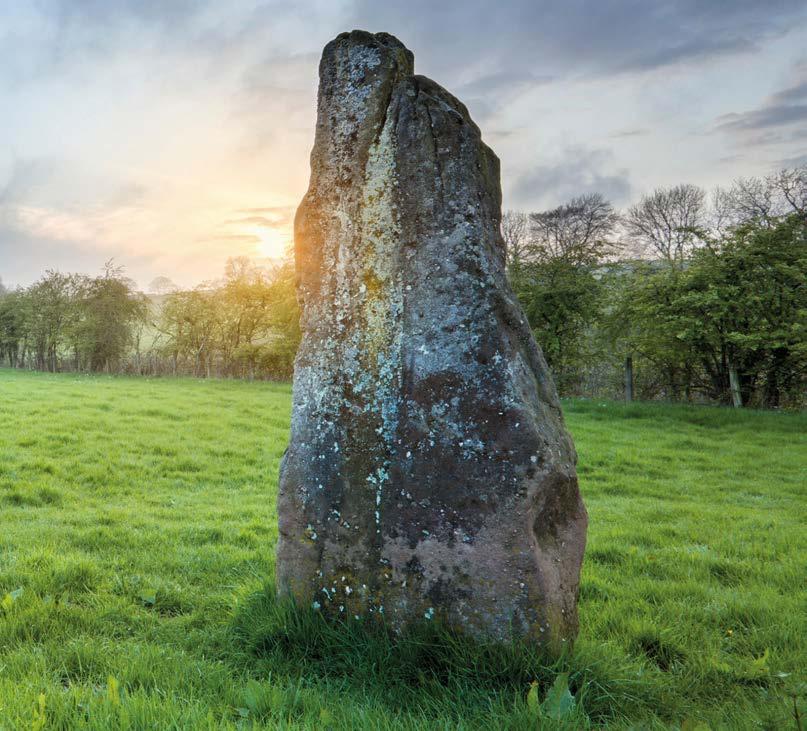
8 minute read
VERDANT VALLEY



The Wye Valley was Britain’s original tourist destination, and there’s more to explore than ever

WORDS JENNY ROWE
The view north along the River Wye from Symonds Yat Rock
Tintern Abbey, as seen from the Devil's Pulpit, a viewpoint along Offa's Dyke Path Right: Chepstow High Street

JON ARNOLD IMAGES LTD/ALAN NOVELLI/ANNA STOWE LANDSCAPES UK/ALAMY © PHOTOS: MICHAEL A HILL © ILLUSTRATION: “If you have never navigated the Wye, you have seen nothing,’ cleric, artist and writer William Gilpin wrote with unwavering confidence in Observations on the River Wye, first published in 1782. Lauded as the birthplace of British tourism, the tranquil landscape of the Wye Valley – a magical borderland straddling England and Wales that covers the southernmost reaches of the Wye’s journey to the Severn Estuary – has entranced visitors ever since. Among them, Romantic poets William Wordsworth and Samuel Taylor Coleridge, who followed in Gilpin’s footsteps on Britain’s first ever package holiday: a pleasure cruise from Ross-on-Wye to Chepstow to take in the ‘picturesque’ valley, a word coined by Gilpin to describe the ostensible theatre-set scenery.
Fifty years ago, the verdant region incorporating the Georgians’ ‘Wye tour’ was quite rightly designated an Area of Outstanding Natural Beauty, all rolling pastures, limestone cliffs, steep wooded slopes and peaceful riverside meadows. Yet delve beneath its picture-perfect surface and you will find tales of toil and struggle, rise and decline, and an altogether more pragmatic side to its history. It is less widely known, for example, that the Wye Valley and nearby Forest of Dean were among the first areas in the UK to industrialise, and today agriculture and craftsmanship remain at its heart. This border country is also marked by millennia of skirmishes and hostilities, with more castles per square mile than anywhere else in the UK, not to mention Iron Age hillforts and the incredibly well-preserved earthwork of Offa’s Dyke.
The full 177-mile Offa’s Dyke Path crosses the England–Wales border (which, from Redbrook, follows the river) more than 20 times, shadowing the dyke that King Offa ordered to be constructed in the 8th century to separate his Kingdom of Mercia


Clockwise, from below: Chepstow Castle above the River Wye; the remains of the south transept at Tintern Abbey; Monmow Bridge in Monmouth


BILLY STOCK/ROBERT HARDING/ROBERT CONVERY/ALAMY/JUSTIN FOULKES/4CORNERS IMAGES © PHOTOS:

ROBERT HARDING/ALAMY/LUIGI VACCARELLA/4CORNERSIMAGES © PHOTOS: in what is now England, from his enemies in what is now Wales. The long-distance walking route links Prestatyn in the north with Chepstow in the south, with the official starting point at Sedbury Cliffs. Follow it a short way from sea level for views over to Chepstow Castle, which towers skyward on a precipitous limestone cliff by the river.
Commissioned by William the Conqueror, Chepstow Castle was begun in 1067 by Earl William FitzOsbern, making it Britain’s oldest surviving post-Roman stone fortification. Although now a ruin, inside you can admire the original castle doors (replicas hang outside), created according to a revolutionary design of the time. Constructed no later than 1190, they are the earliest known surviving castle doors in Europe.
Chepstow’s Old English name, which means marketplace, still holds true, and many of the town’s Georgian and Victorian buildings showcase independent businesses and boutiques, while the High Street and Beaufort Square fill with stalls during the Chepstow Town Market on the second and last Sunday of every month. A few hundred yards east, FitzOsbern also founded a priory in 1071. Now St Mary’s Priory Church, some of its original 12th-century structures have survived, including the semicircular arch at its west doorway.
By far the most iconic monastic house on the Wye is the romantic ruin of Tintern Abbey, a few meanders north of Chepstow in a small village that is largely made up of cute cafés and country pubs. Founded by Cistercian monks in 1131, it began as a simple wooden structure where Abbot Henry, a former robber, was known to regularly weep over the altar in repentance. Over the following few centuries, the abbey bloomed into a shining example of British Gothic architecture, only to be dissolved by Henry VIII in 1536 and abandoned ever since. If you’re walking Offa’s Dyke, easily joined from Tintern village, a break in the trees at Devil’s Pulpit – a rock so-called, as legend has it, because it was where the devil preached to the monks below – allows you to appreciate the remote location the abbey once had, isolated as it would have been within the steep-sided, thickly forested valley.
Another less popular but notable relic of the Wye Valley is set a little way from the river at the unassuming one-pub village of Trelleck. When inquisitive moles began excavating shards of medieval pottery in a local field in 2004, a bold young archaeology graduate and resident used his life savings to buy it, acting on no more than a hunch that there was something far bigger hidden below. He was right. Unearthing a fortified manor house,
round stone tower and heaps of medieval pots and metalwork within 15 years, Trelleck was revealed to have been one of the biggest towns in Wales in the mid-13th century.
Its roots as a settlement stretch even further back, evident thanks to the survival of Harold’s Stones, a row of three megalithic stones set in the ground a few fields over and dating back to the Neolithic Period. And finally, as if this tiny, sleepy village couldn’t be more beguiling, the Virtuous Well can be found a short walk down Llandogo Road. There are many curious legends associated with this horseshoe-shaped well, one being that Tintern Abbey tapped into its flow of iron-rich healing waters via a three-mile-long tunnel.
Continuing north, head to Monmouth, which, if you can believe it, is a town as big as Trelleck once was. Start your explorations in Agincourt Square, where you can go inside the Georgian Shire Hall, the former county assize courts, and visit the fully restored ‘Courtroom 1’. A statue of Henry V also stands in the square; born in 1386/7 in the now ruined Monmouth Castle, and known as ‘Henry of Monmouth’, he is by far the town’s most famous son.
At the convergence point of three rivers – the Wye, Monnow and Trothy – there are several bridges of note in Monmouth, the most impressive being Monnow Bridge, which is the only remaining fortified bridge in Britain. You can get a better sense of how the town has developed around its waterways by climbing the Kymin, an 840-foot hill overlooking the town and the wider valley. With over 20 million trees spread across the Wye Valley and Forest of Dean, autumn-time provides particularly rich, colourful views. Now a National Trust site, the Kymin has been a popular picnic site since the late 18th century when the gleaming white Round House and the unique Naval Temple, celebrating Britain’s maritime victories and most famous admirals, were both built.
Another scenic lookout can be found further north at Symonds Yat Rock, where you’ll find arguably the best view of the Wye in the whole of the valley. Formerly the site of an Iron Age hillfort, the limestone cliffs beneath the viewpoint make ideal nesting places for peregrine falcons and other birds of prey, which can be spotted soaring above the river.
Finally, the red sandstone Goodrich Castle, also perched on a hill (the aerial theme continues), offers a different perspective of Symonds Yat Rock. The castle’s 12th-century, three-storey keep is coupled with extensive 13th- and 14th-century ruins, and a free audio tour brings to life the devastating Civil War siege that saw Goodrich, a Royalist stronghold, crumble.
Now you are nearing Ross-on-Wye and the end of a modern-day ‘Wye tour’. With many natural and man-made landmarks now more accessible than they were in Gilpin’s time, today’s ‘picturesque’ Wye Valley is more enlightening and varied than the Georgians could have dreamed of.
Right: The red sandstone ruin of Goodrich Castle Below: Harold's Stones in the village of Trelleck




For more on the British countryside, visit www.britainmagazine.com


LOOP IMAGES LTD/FUNKYFOODLONDON - PAUL WILLIAMS/ALAMY © PHOTOS:
THE PLANNER
GETTING THERE & AROUND It takes around 2 hours 30 minutes to travel to Chepstow from London via train, with one change at either Gloucester or Newport (South Wales). Though a car might make your visit easier, local bus services reliably run throughout the AONB stopping at all major attractions, towns and villages. www.thetrainline.com; www.traveline.info
EAT, DRINK, SLEEP Tintern Old Rectory is a traditional, comfortable B&B with period decor, an open fire and bags of old-world charm. Enjoy a traditional Wye Valley breakfast – featuring Welsh specialties such as the Glamorgan ‘sausage’, which is actually vegetarian – and a warm welcome from knowledgeable local hosts Anika and Ian.
The luxury option is The Whitebrook, a stylish restaurant with rooms that boasts a Michelin star. Using locally sourced food, Chris and Kirsty aim to recreate the valley on your plate.
To sample local delicacies at less cost, drop in at The Marches Deli in Monmouth, which stocks a range of delights produced locally. www.tintern-oldrectory.co.uk; www.thewhitebrook.co.uk; www.marchesdeli.co.uk
i
FURTHER INFORMATION www.visitdeanwye.co.uk










